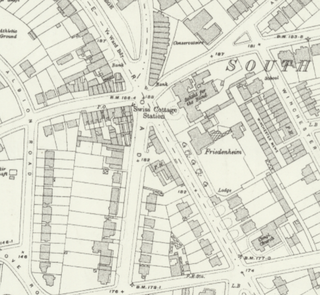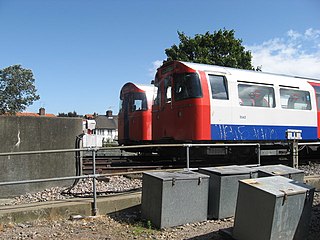
The Metropolitan line, colloquially known as the Met, is a London Underground line between Aldgate in the City of London and Amersham and Chesham in Buckinghamshire, with branches to Watford in Hertfordshire and Uxbridge in Hillingdon. Printed in magenta on the tube map, the line is 41.4 miles (66.7 km) in length and serves 34 stations. Between Aldgate and Finchley Road, the track is mostly in shallow "cut and cover" tunnels, apart from short sections at Barbican and Farringdon stations. The rest of the line is above ground, with a loading gauge of a similar size to those on main lines. Just under 67 million passenger journeys were made on the line in 2011/12.

The Bakerloo line is a London Underground line that runs from Harrow & Wealdstone in suburban north-west London to Elephant & Castle in south London, via the West End. Printed in brown on the Tube map, it serves 25 stations, 15 of which are underground, over 23.2 kilometres (14.4 mi). It runs partly on the surface and partly through deep-level tube tunnels.

The Jubilee line is a London Underground line that runs between Stanmore in suburban north-west London and Stratford in east London, via the Docklands, South Bank and West End. Opened in 1979, it is the newest line on the Underground network, although some sections of track date back to 1932 and some stations to 1879.

Waterloo is a London Underground station located beneath Waterloo National Rail station. As of 2022, it is the 2nd busiest station on the London Underground, with 68.72 million users. It is served by four lines: the Bakerloo, Jubilee, Northern and Waterloo & City lines.

Baker Street is a London Underground station at the junction of Baker Street and the Marylebone Road in the City of Westminster. It is one of the original stations of the Metropolitan Railway (MR), the world's first underground railway, opened on 10 January 1863.

Kingsbury is a London Underground station in northwest London, England. It is on the Jubilee line between Queensbury and Wembley Park stations, in Zone 4, in the borough of Brent.

Wembley Park is a London Underground station in Wembley Park, north west London. The station is served by the Jubilee and Metropolitan lines and is in Travelcard Zone 4. It is located on Bridge Road (A4089) and is the nearest Underground station to the Wembley Stadium and Wembley Arena complex. This is where the Jubilee line from Stanmore diverges from the Metropolitan line, which was formerly a branch of the Metropolitan Railway and was taken over by the Bakerloo line and today part of the Jubilee line.

Neasden is a London Underground station in Neasden. It is on the Jubilee line, between Wembley Park and Dollis Hill stations. Metropolitan line trains pass through the station but do not stop, except on rare occasions. The Chiltern Main Line/London to Aylesbury Line runs to the west of the station.

Willesden Green is a London Underground station on Walm Lane in Willesden. It is served by the Jubilee line and is between Dollis Hill and Kilburn stations. Metropolitan line trains also pass through the station, but do not usually stop. The station is in both Travelcard Zone 2 and Zone 3.

Kilburn is a London Underground station near Brondesbury Park in north-west London. It is on the Jubilee line, between Willesden Green and West Hampstead stations and is in Travelcard Zone 2. The station is on the A5 Kilburn High Road or Shoot-up Hill, approximately 0.1 miles (0.16 km) north of Brondesbury station. Metropolitan line trains typically bypass the station without stopping.

West Hampstead is a London Underground station in West Hampstead. It is located on West End Lane between Broadhurst Gardens and Blackburn Road and is situated in Travelcard Zone 2. It is on the Jubilee line between Kilburn and Finchley Road stations. It is 100 m (110 yd) from West Hampstead station on the London Overground North London line and 200 m (220 yd) from West Hampstead Thameslink station. Metropolitan line trains also pass through the station, but do not usually stop.

Finchley Road is a London Underground station at the corner of Finchley Road and Canfield Gardens in the London Borough of Camden, north London. It is on the Jubilee line, between West Hampstead and Swiss Cottage stations and on the Metropolitan line between Wembley Park and Baker Street stations. It is in Travelcard Zone 2.

Swiss Cottage is a London Underground station at Swiss Cottage, north London. It is on the Jubilee line, between Finchley Road and St John's Wood stations. It lies in Travelcard Zone 2 and is located at the junction of Finchley Road, Avenue Road and College Crescent. The station is a local station, with the Metropolitan Line bypassing the station nearby.

Canons Park is a London Underground station at Canons Park of the London Borough of Harrow, north London. It is on the Jubilee line, between Stanmore and Queensbury stations and is in Travelcard Zone 5. It is also the least used station on the Jubilee line with an average of 1.68 million passengers per year.

Stanmore is a London Underground station in Stanmore. It is the northern terminus of the Jubilee line and the next station towards south is Canons Park. The station is on the south side of London Road and is in Travelcard Zone 5.

Lord's was a London Underground station located in St John's Wood, north-west London.

Marlborough Road is a disused London Underground station in St John's Wood, northwest London NW8, England. It opened in April 1868 on the Metropolitan & St. John's Wood Railway, the first northward extension from Baker Street of the Metropolitan Railway. It is located at the junction of Finchley Road and Queen's Grove.

Swiss Cottage is a disused London Underground station in Swiss Cottage, north-west London. It was opened in 1868 as the northern terminus of the Metropolitan and St. John's Wood Railway (M&StJWR), the first northward branch extension from Baker Street of the Metropolitan Railway.
The New Works Programme of 1935–1940 was the major investment programme delivered by the London Passenger Transport Board (LPTB), commonly known as London Transport, which had been created in 1933 to coordinate underground train, tram, trolleybus and bus services in the capital and the surrounding areas. The programme was to develop many aspects of the public transport services run by the LPTB and the suburban rail services of the Great Western Railway (GWR) and London and North Eastern Railway (LNER). The investment was largely backed by government assistance as well as by the issuing of financial bonds and was estimated to cost £42,286,000 in 1936.

Stonebridge Park Depot is a stabling and maintenance depot for trains on the Bakerloo line of the London Underground in England. It opened in 1979, as part of the restructuring that resulted in the Bakerloo line's Stanmore branch becoming part of the Jubilee line. It is the main depot on the Bakerloo line, and has been used for stabling stock dating from 1938, 1959 and 1972. In addition, trains of 1972 Stock from the Northern line have been transferred to the depot temporarily for overhaul.





















